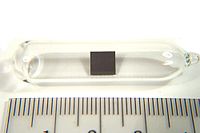
Photo from wikipedia
The influence of sodium and rubidium postdeposition treatment on the quality of Cu(In,Ga)Se2 thin-film absorbers is investigated. The quasi-Fermi level splitting (QFLS), measured via photoluminescence (PL), is used as the… Click to show full abstract
The influence of sodium and rubidium postdeposition treatment on the quality of Cu(In,Ga)Se2 thin-film absorbers is investigated. The quasi-Fermi level splitting (QFLS), measured via photoluminescence (PL), is used as the metric of quality of the absorber. To evaluate the QFLS values in the graded absorber of state-of-the-art devices, it is necessary to know at which location the luminescence is generated. Here we show, by measuring the PL in different geometries, that the photons originate from the global band gap minimum inside the bulk. We use this knowledge to compare the QFLS in different absorbers, where our results show that the QFLS is higher in absorbers that were treated with NaF + RbF than in absorbers that were only treated with NaF or not treated at all. We attribute this increase to a reduced nonradiative recombination, even before cadmium sulfide deposition. A decreased difference between QFLS and open-circuit voltage in the corresponding finished solar cells also reveals an improved CdS/CIGS interface. Both effects ultimately lead to a higher efficiency.
Journal Title: IEEE Journal of Photovoltaics
Year Published: 2018
Link to full text (if available)
Share on Social Media: Sign Up to like & get
recommendations!